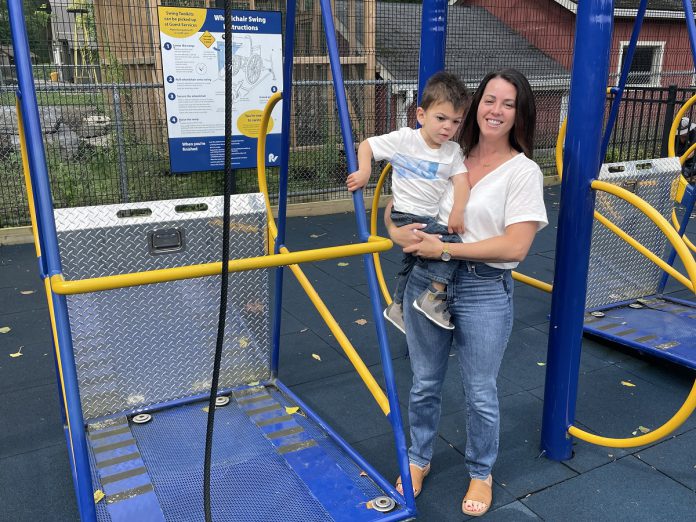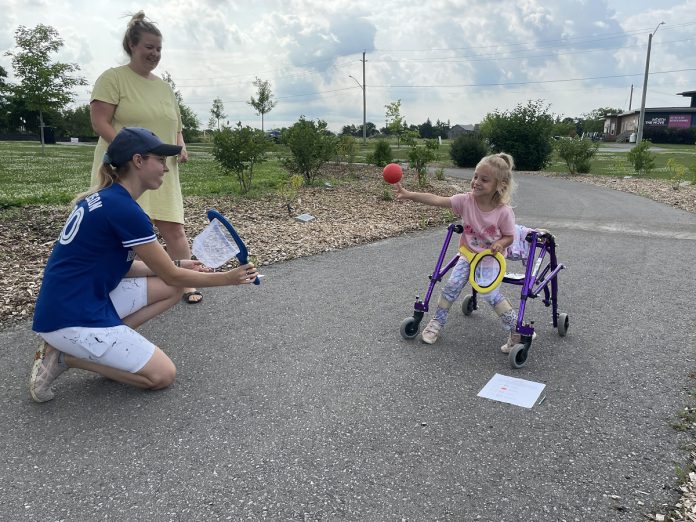
Playgrounds are more than child’s play. In many ways, they help lay the building blocks for life.
Play is how kids learn, and unstructured play opportunities — like those on playgrounds — benefit children in many ways. Kids can be active, explore, socialize, interact, problem solve and be independent.
Many families take going to the playground for granted, but Julie Grant isn’t one of them. Her two-year-old son, Jude, has cerebral palsy and developmental delays and receives treatment at Five Counties Children’s Centre. For kids like Jude, barriers and obstacles to play (including on a playground) can put them at a disadvantage with their peers. They miss out on the fun, fitness, and fellowship with others.
As a mother, Julie is passionate about the right of children of all ages and abilities to enjoy play, especially on playgrounds. As Julie notes, “My sweet boy loves to crawl, sing, play with water and explore the world around him. And although he doesn’t yet walk (he’s trying hard), or talk and is delayed, he still deserves the ability to play at a playground in some capacity. Every child deserves that.”
We couldn’t say it better. Accessibility and inclusion should be considered hallmarks of any society, and where better to demonstrate this than on the playground?
Studies show that children with disabilities are four times less likely to get exercise outside of school than other children. This impacts their mental health, anxiety, fitness and overall well-being.

Accessible playgrounds (or ones with accessible features) benefit all children, regardless of their ability. Creating accessible play spaces allow children with exceptionalities and those without to interact and have fun together. Playgrounds become places to build understanding and empathy, while forging new friendships between kids of different ages and abilities.
This breaks down barriers to play and promotes diversity in all walks of life.
By creating these accessible spaces in a park setting, we help children understand inclusion and acceptance of others, which they stand to benefit from for their entire lives.
We’re fortunate to have shining examples of accessible playgrounds in our region, as well as resources to create even more:
- Peterborough’s Riverview Park and Zoo has many accessible features for families to enjoy, including wheelchair swings that are believed to the be the only ones of their kind in Ontario.
- ‘Zac’s Dream’ is a fully accessible playground located in Port Hope’s Memorial Park. It was championed by Zac Andrus, a one-time Five Counties client and inspirational youth advocate, who led community fundraising efforts some years ago to see the playground go from dream to reality.
- Ontario Parks offer a number of a accessible features at provincial beaches, including beach mats and floating wheelchairs.
- The EPIC Lab Inclusive Playgrounds Playbook is an excellent guide created in association with Holland Bloorview Kids Rehabilitation Hospital. The playbook offers municipalities, groups and families a step-by-step guide to create inclusive playgrounds from concept to completion.
- Inclusive Play Spaces from the Jumpstart Foundation is a potential funding partner for municipalities and community groups looking to start and build accessible playground features.

Julie also believes in “championing this journey of inclusiveness and accessibility” for her son Jude and others. It’s why she formed the Accessible Playgrounds Ontario Facebook group to let families share locations and photos of accessible playgrounds. Using this data, Julie has compiled a Google Maps list of accessible playgrounds that have rubber or turfed surfacing, which make using them easier to access for kids in wheelchairs or mobility devices.
“It may feel like globally we still have a long way to go for an inclusive world,” Julie notes, “but let’s celebrate the efforts of our communities and highlight how far we have come with inclusive play.”
How far we’ve come, and how much more we can yet achieve together!


























